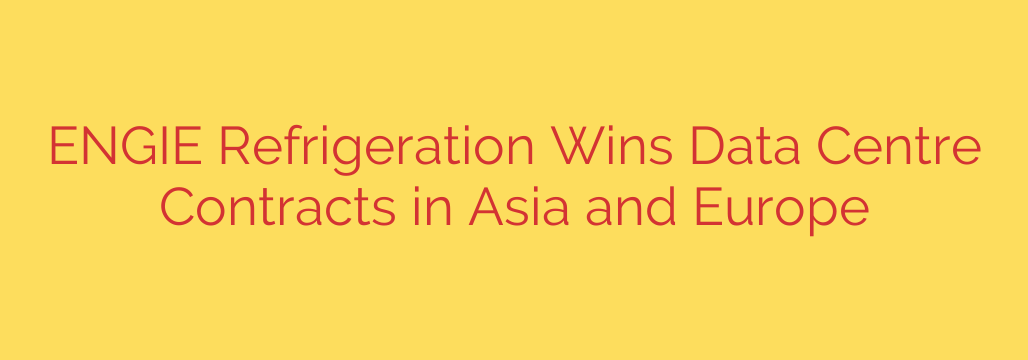
Powering the Digital Age: How Advanced Cooling Is Making Data Centers More Sustainable and Efficient
The insatiable global demand for data, driven by everything from cloud computing and AI to streaming services, has placed enormous pressure on the digital infrastructure that supports our world: the data center. But as these facilities become more powerful, they face a critical challenge—managing the immense heat they generate. Inefficient cooling is not just an operational risk; it’s a massive drain on energy and a significant contributor to a company’s carbon footprint.
Today, a new wave of highly efficient and sustainable cooling technology is being adopted by forward-thinking data center operators across the globe, signaling a crucial shift in how we power the digital economy.
The Overheating Problem: A Drain on Power and Budgets
For any data center, reliability is paramount. Overheating components can lead to performance degradation and catastrophic hardware failures, resulting in costly downtime. To prevent this, massive cooling systems run 24/7, often consuming up to 40% of a data center’s total electricity. This has a direct impact on two key metrics:
- Power Usage Effectiveness (PUE): A measure of how efficiently a data center uses energy. A lower PUE indicates a more efficient facility, and cooling is one of the biggest factors.
- Total Cost of Ownership (TCO): High energy consumption and constant maintenance for older cooling systems drive up long-term operational expenses.
As the industry expands, the need for cooling solutions that are not only powerful but also smart and sustainable has become non-negotiable.
A Technological Leap in Cooling Solutions
Recent advancements in chiller technology are providing the answer. Leading data center operators in Europe and Asia are now implementing state-of-the-art, water-cooled chiller systems that set new standards for performance and environmental responsibility. These systems are being chosen for both new builds and facility expansions due to their proven ability to deliver reliable cooling with exceptional efficiency.
For example, a major telecommunications provider in Germany is integrating six of these advanced chillers into a new data center, providing a total cooling capacity of 9 megawatts. Similarly, a leading international data center operator in Singapore is expanding its capacity with four new chillers, adding over 6 megawatts of highly efficient cooling to its facility.
These real-world applications highlight a clear trend: the industry’s leaders are investing in technology that offers both economic and ecological benefits.
Key Features Driving Global Adoption
What makes these modern cooling systems so effective? The innovation lies in a combination of intelligent design and cutting-edge components.
Unmatched Energy Efficiency: At the heart of these chillers are oil-free, magnetic-bearing compressors. By eliminating friction-causing oil from the system, these compressors achieve significantly higher efficiency levels, especially under partial-load conditions, which is how data centers operate most of the time. This directly lowers energy consumption and reduces PUE.
Exceptional Reliability and Low Maintenance: The absence of a complex oil management system means fewer moving parts, less wear and tear, and a drastic reduction in maintenance requirements. For data center operators, this translates to greater uptime and lower service costs over the life of the equipment.
Commitment to Sustainability: These next-generation chillers utilize refrigerants with a very low Global Warming Potential (GWP), such as R-1234ze. This proactive approach helps data centers meet increasingly strict environmental regulations and achieve corporate sustainability goals.
Lower Total Cost of Ownership (TCO): While the initial investment may be a consideration, the long-term savings are compelling. The combination of reduced energy bills, minimal maintenance needs, and high reliability results in a significantly lower TCO compared to traditional cooling technologies.
Actionable Advice for Data Center Operators
For decision-makers planning to build or upgrade a data center, the focus must be on future-proofing the facility. When evaluating cooling infrastructure, consider the following:
- Look Beyond Upfront Costs: Analyze the TCO, factoring in projected energy consumption and maintenance schedules over a 10-to-15-year period.
- Prioritize Efficiency at All Loads: Ensure the chosen solution performs efficiently not just at peak capacity but also at the variable partial loads typical of a data center environment.
- Verify Sustainability Credentials: Scrutinize the refrigerant used. Opting for a low-GWP solution is not just an environmental choice but a strategic one that avoids future regulatory compliance issues.
- Demand Proven Reliability: Seek technology with a track record of performance in mission-critical applications. Oil-free, magnetic-bearing systems have become a gold standard for dependability.
The digital world will only continue to grow, and with it, the demand for data processing. The future of the industry depends on building a foundation that is not just powerful, but also profoundly efficient and sustainable. Investing in advanced cooling technology is no longer an option—it is a strategic imperative for success.
Source: https://datacenternews.asia/story/engie-refrigeration-secures-key-data-centre-deals-in-asia-europe








